In this article, we will cover the topic of what crypto derivatives are, their variations, as well as how to trade them. So let’s dive in!
What are crypto derivatives?
Before we move to crypto derivatives, let’s talk about what derivatives mean in “traditional” markets.
In the traditional market, a “derivative” refers to a product or contract whose value is determined by an underlying asset. Exchange rates, commodities, currencies, stocks, and the rate of interest can serve as examples of derivative assets. The buyer and seller of such products or contracts bet on the future trading price. In order to earn a profit, both a buyer and a seller wager on the underlying assets’ future value.
Let’s create a hypothetical scenario and illustrate it with the example of a physical asset. For instance, you would like to speculate on the price of oil. You have the option to actually go and buy barrels of oil and then sell them when prices go up. Certainly, this is too tiresome and impractical, since you would also have to consider storage as well as transportation fees. A much more convenient approach would be to trade a contract whose price is tethered to that of oil instead.
A crypto derivative works just like a traditional derivative in that both a buyer and seller enter the contract to sell an underlying asset (e.g., cryptocurrency). Two parties enter into a financial contract to speculate on the cryptocurrency’s future price. On the day of the trade, both crypto traders have to honor the price (both buying and selling) that was decided on the day the contract was signed, regardless of the market price. As a result, investors can profit from changes in the underlying asset’s price by purchasing the currency at a cheaper price and selling it at a higher price.
Imagine that you believe the price of a crypto asset, say Bitcoin, will go up in the near future, while another person believes the price will go down. Both you and another trader sign an agreement stating that after a certain period of time, once the price has moved in any direction, one of the parties will have to pay the other the difference in price. When the day of the trade arrives, some of you two will profit.
For instance, the price of ETH is at $2,000, and you bet it will go up, while your counterparty bets it will go down. In the event that the price has moved to $3,000 by the time you settle the contract, your counterparty will have to pay you $1,000.
If the price falls to $1,000, you will be required to pay $1,000.As you can see, via such contracts, a trader can make money even when prices go down without even having to own the underlying asset, in our case, ETH.
There are two broad categories of derivatives: exchange-traded and over-the-counter derivatives. Exchange-traded derivatives are instruments that are traded in exchange. Over-the-counter derivatives are those instruments that are created and customized by the parties involved. The most common types of derivatives are futures, forwards, options, and swaps.

Most popular types of crypto derivatives
Depending on the conditions of a contract, you can come across different types of crypto derivatives:
- Futures. A futures contract refers to a legal agreement between two parties to buy or sell an underlying asset at a specified price and date in the future. A futures contract obliges the buyer to purchase an asset at a previously agreed price on a specific date in the future, even if it has lost value relative to their agreed fee. And likewise, the seller is also obliged to sell an asset at the agreed price, even if its value is gone. Futures contracts are traded on almost every major cryptocurrency exchange, making them similar, standardized, and widely available to traders.
- Perpetual contracts. A perpetual contract somewhat resembles a futures contract in a way that it allows traders to speculate on the future price movements of digital assets; however, unlike futures, perpetual swaps don’t have an expiration date. The traders can hold the assets for a very long period of time, and there is no settlement date. Sometimes, under certain circumstances (e.g., a trader holds a certain amount of a crypto in his or her account, etc.), traders can keep their positions open indefinitely. It is worth noting that on crypto exchanges, perpetual contracts reside in the futures section.
- Options. Options are similar to futures, except that they offer a choice rather than an obligation. With an options contract, a trader has the option — but not the obligation—to buy or sell the underlying asset at a specified price and future date. Traders are allowed to trade options on any future date or price.
- Forwards. Forwards are also similar to futures, but with a few differences. Unlike futures, forwards can be customized, making them more flexible. However, traders have to remember that forwards are generally traded on OTC (over-the-counter) platforms, so it is vital to take the associated risks into account.

How do crypto derivatives work?
Cryptocurrency derivatives are most commonly used either for hedging or speculation. So what does this mean exactly?
Hedging is a risk management strategy that seeks to reduce the risk of losing an existing position by opening new positions that have a negative or positive correlation to the trader’s existing position. Hedging is used to protect a trader’s portfolio and minimize potential losses.
For instance, if we take futures as an example, then it can help to protect investments without interfering with or compromising current holdings, since futures allow a trader to hedge his or her portfolio for a fraction of its cost. If your portfolio is worth $10,000, you can hedge it by opening a short position in a futures contract: a 10x contract will cost $1,000, or one-tenth of the portfolio’s overall value.
Hedging might be very helpful, especially during a bearish trend, since utilizing this strategy is a much better option than waiting for the price to recover or selling your assets at lower prices.
Speculating, on the other hand, refers to betting that the price of a digital asset will either increase or decrease and then entering either a short or long position to gain potential profit from this bet. Since crypto options and futures use leverage, any gains are potentially amplified, and losses, likewise, would potentially be amplified.
For example, if you buy Ethereum, you can profit by selling it when the price rises.However, if the market is dominated by a bearish trend, it is impossible to profit by simply selling your asset, as you will incur a loss due to the constant drop in prices.
Futures, for instance, can lend you a hand here. You can bet that the price will fall, and if Ethereum continues to fall in value, you will be able to profit despite the bearish trend.
What are the benefits of crypto derivatives?
You might ask yourself if there are any advantages to using crypto derivatives. Let’s take a look at some of them.
Risk management
The volatility of the market is one of the most difficult obstacles in crypto trading. Derivatives can help crypto traders hedge against investment risks that help reduce the risks of the market.
For instance, if a trader buys a derivative contract and the underlying asset’s value goes down, he or she can offset the losses with gains from derivatives. Thus, derivatives are used to reduce the risks brought on by changing underlying asset prices.
Low transaction costs
Crypto derivatives are trading tools that reduce the cost of market transactions. As a result, if we compare derivatives to other securities like spot trading, we can see that the costs in derivative trading are lower.
Market efficiency
Derivatives trading helps to ensure that the market prices of underlying assets are accurate, and it also helps the market find equilibrium and stability.
High liquidity
Professional and institutional traders frequently invest in cryptocurrency derivatives, thus adding to the market’s liquidity. Increased liquidity means that there are more buyers and sellers in the market and more transactions can take place, so the market stays active and alive.
Diversification
Derivatives can be a helpful addition for both new and experienced crypto investors.
Since derivatives can help investors and traders minimize their portfolio risks, especially during turbulent times, it might be wise to consider adding some of them to your crypto portfolio.

What are the disadvantages of crypto derivatives?
Certainly, nothing is perfect, and crypto derivatives also have their own share of disadvantages. Let’s take a look at some of them down below:
Legal status
In some countries, crypto derivatives are still struggling to get a fully legal status. As follows, in case a trader wishes to participate in derivatives trading, he or she must reside in the area where their status is legal in order to avoid criminal investigations.
Lack of due diligence
If we talk about over-the-counter (OTC) derivatives, then you should remember that they don’t always follow compliance procedures, and a trader simply cannot run a due diligence check on the other party. Thus, they can pose certain financial risks for traders.
Risk of speculation
Derivative contracts, especially that are traded with leverage, can be used as speculative instruments. Speculative investments may result in huge losses due to the high risk they carry and the unpredictability of their value swings.
Final thoughts
Crypto derivatives can be helpful instruments in managing risks against the volatile nature of the crypto market. Derivatives trading allows traders to hedge the underlying crypto assets and mitigate risks through future predictions and betting on crypto market prices.
Before trading derivatives, you should always strategize and conduct your due diligence, and in that case, the benefits will prevail over the risks.
